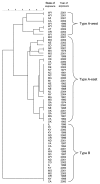Epidemiologic and molecular analysis of human tularemia, United States, 1964-2004
- PMID: 16836829
- PMCID: PMC3291054
- DOI: 10.3201/eid1207.051504
Epidemiologic and molecular analysis of human tularemia, United States, 1964-2004
Abstract
Tularemia in the United States is caused by 2 subspecies of Francisella tularensis, subspecies tularensis (type A) and subspecies holarctica (type B). We compared clinical and demographic features of human tularemia cases from 1964 to 2004 from 39 states in which an isolate was recovered and subtyped. Our data indicate that type A and type B infections differ with respect to affected populations, anatomic site of isolation, and geographic distribution. Molecular subtyping with pulsed-field gel electrophoresis further defined 2 subpopulations of type A (type A-east and type A-west) that differ with respect to geographic distribution, disease outcome, and transmission. Our data suggest that type A-west infections are less severe than either type B or type A-east infections. Through a combined epidemiologic and molecular approach to human cases of tularemia, we provide new insights into the disease for future investigation.
Figures




References
-
- Olsufiev NG, Meshcheryakova IS. Infraspecific taxonomy of tularemia agent Francisella tularensis McCoy et Chapin. J Hyg Epidemiol Microbiol Immunol. 1982;26:291–9. - PubMed
-
- Jellison WL, Owen C, Bell JF, Kohls GM. Tularemia and animal populations: ecology and epizootiology. Wildl Dis. 1961;17:1–22.
-
- Johansson A, Ibrahim A, Goransson I, Eriksson U, Gurycova D, Clarridge JE III, et al. Evaluation of PCR-based methods for discrimination of Francisella species and subspecies and development of a specific PCR that distinguishes the two major subspecies of Francisella tularensis. J Clin Microbiol. 2000;38:4180–5. - PMC - PubMed
MeSH terms
LinkOut - more resources
Full Text Sources
